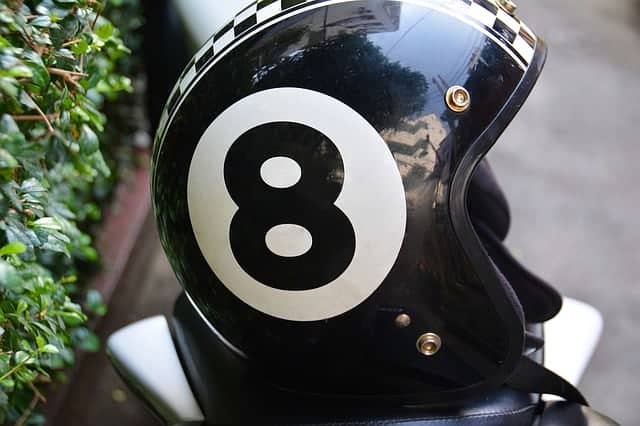
If you have ever thought about flying somewhere with your motorcycle gear, you may wonder what exactly you will have to pay to transport and what you can carry for free. Your helmet would be the biggest object that you need to transport.
Does a motorcycle helmet count as a carry on item? Every major airline in the United States will let its customers bring both a personal item and a carry on item. These items are categorized by size. A motorcycle helmet is categorized as a carry on, leaving you open to also bringing a backpack, purse or other small personal item.
Many people want to take their personal helmet with them when they fly somewhere for a track day, long road trip, or when flying out of the country and hoping to get some riding in. And renting a used helmet is kind of gross and uncomfortable. Find out below how to fly with your helmet.
Does A Motorcycle Helmet Count As A Carry On Or Personal Item?
So, as we just explained, you can take your motorcycle helmet onto a plane with you as either a carry-on item or personal item. The TSA has also allowed helmets to be transported in checked baggage as well. Some airlines will only classify a helmet as a carry on since it won’t fit below your seat and will be required to be put in the overhead storage space.
Airlines have done their best to make things easy for those traveling with motorcycle gear. Much like how strollers and car seats can be loaded onto a plane easily, you do not have to worry about bringing your motorcycle gear. Airlines have done their best to make traveling as convenient for everyone as possible to encourage people to travel. The TSA has also come out to say that helmets are safe to travel with.
If you do travel with a motorcycle helmet and other gear, you likely will get some strange looks and raised eyebrows though. People are not very used to seeing people travel with these things and you may end up having to explain yourself.
If a TSA agent tries to tell you that you cannot bring your helmet with you, you may actually be denied permission to take the helmet. Ultimately, the TSA agents have the last say as to what can and cannot be taken, and if they find a specific reason why your helmet shouldn’t travel, you may be forced to leave your helmet behind.
While this may be frustrating, remember to keep calm and to talk with the agent and try to understand their concern with you taking your helmet. You may be able to help them resolve any concerns that they have.
There are many different reasons why you may want to take your motorcycle gear with you on a plane. As rentals are becoming more and more available, you can now get a motorcycle almost anywhere in the world. That means you can ride essentially anywhere without the hassle of physically getting your motorcycle over there.
You can just show up, rent a motorcycle, and return it when you are done. What can be difficult is getting good riding gear while you are abroad. For this reason, you may want to bring your own helmet, boots, gloves, and jackets.
If you are looking to buy a motorcycle a distance from where you live, you may consider flying there and riding the motorcycle back home. This is a good way to get some quality bonding time with your motorcycle right away and can be a little more fun than bringing a trailer with you to tow it home.
You also may be going on vacation to visit friends and/or family who have motorcycles. Knowing this, you may want to bring your own riding gear, so you are prepared for the weekend. Regardless of the reason, you can be prepared for any riding abroad by bringing your own gear with you.
How To Protect Your Helmet During A Flight
If you decide to take your helmet on a flight with you, what can you do to protect it during the flight? The first thing that you can do is to not have your helmet travel as a checked bag. This is the most likely way to end up with a scratched, dented, or broken helmet.
Checked bags are often treated with very little care and end up being buried under the other bags. If you put your motorcycle helmet into a checked bag, it is extremely likely that you will end up with a damaged helmet.
If you absolutely must check it, it is important that you properly put padding around the helmet. This could be done by wrapping the helmet in some sort of padding. If you can avoid checking your helmet, that is always better.
If you are bringing your helmet as a carry on, it is much easier to keep it safe from harm. This is due to the fact that you are the one in charge of your carry on. You put the helmet where you want it to be and you are responsible for moving it from one place to another. You will still want to be cautious though.
The best and simplest way to keep your helmet safe is by carrying it around in a padded helmet bag. This will prevent it from getting scratched by other objects and also protect it from minor dings. This is a simple way to make sure your helmet does not get trashed next time you fly with it.
Shipping Your Helmet Ahead Of Time vs Flying With It On The Plane
Is it ever better to ship your helmet to your destination ahead of time rather than bringing it with you on the plane? This is another option, and it has its pros and cons as does carrying it on the plane. The main pro to shipping your helmet is that you do not have to hassle with it in the airport or on the plane.
You can enjoy your travel a little bit more knowing that your helmet is waiting for you when you get there. This way you will not have to worry about it getting damaged in baggage. You also can save a little bit of money by doing it this way.
Carry-on and checked baggage can cost you around $50-60 each way. If you choose to ship your helmet, you may be able to do this for around $20-30 each way. This is not a huge savings, but it will save you some money.
The major cons to shipping your helmet is that you must plan ahead of time. If you choose to ship your helmet over, you need to allow enough time for the helmet to arrive to your destination. If there are any delays or incidents on the shipping services part, you may not get your helmet in time.
It is a little more guaranteed to just carry the helmet around with you. Another major con to shipping the helmet is that you need a place where you can ship it to. If you are traveling somewhere where you have never been before and do not know anyone who lives there, you may not have a place to ship the helmet to.
It is up to you to decide what is best for you. Bringing a helmet with you on a flight will guarantee that you always have your helmet at your destination, but you will have to deal with the hassle of traveling with and protecting your helmet. Whatever you think is the best way to get your helmet from point A to point B is up to you.
Do All Airlines Allow Helmets As A Carry On?
While essentially all airlines allow helmets as carry-ons, there are times when you may not be able to bring a helmet with you on a flight. The TSA has approved helmets for both carry-ons and checked bags. This means that in theory, you should be approved to fly anywhere with these. Although there still are reasons why a TSA agent may find your helmet inappropriate for travel.
If an agent feels that your helmet is at all dangerous or that it could be used inappropriately, they may not allow you to take it on the plane. This could be a result of things that you have added to the helmet or even damage to the helmet that alters its appearance drastically. If a TSA agent feels uncomfortable with you bringing your helmet with you, then you likely will not be able to take it.
As you travel to many different countries, you may notice even more differing opinions on helmets. While traveling domestically in the US, it is not very likely that you run into issues with bringing your helmet.
As you travel more and more into international airports in different countries, you will often have a much harder time getting your helmet through. So, if you are traveling to a foreign airport, it’s always best to call beforehand and make sure that you can bring your helmet.

